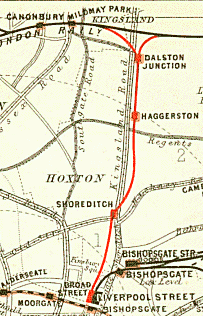
Shoreditch was a railway station on the North London Railway (NLR) in Shoreditch, London, that was in use from 1865 to 1940. It was situated on a viaduct between Haggerston and Broad Street stations. It should not be confused with Shoreditch Underground station (1869–2006) on the London Underground, situated about half a mile further south. It was also not the first main line railway station to possess the Shoreditch name; Bishopsgate (1840–1875) was originally given that name.

Glenans Irish Sailing Club (GISC) was a non-profit sailing school affiliated to, but independent of the larger French Les Glénans sailing school. The Irish club was founded in 1969 as part of the French school. It gained independence in 1985, operating successfully for 25 years, but following an economic downturn it was reintegrated with the French school in 2010. Glenans Irish Sailing Club offered courses in cruisers, catamarans, dinghies and windsurfing. The sailing bases were in Lawrence Cove on Bere Island County Cork, Collanmore Island in Clew Bay, and the club's original base (founded in 1969) at a converted railway station in Baltimore, County Cork. The Baltimore and Collanmore bases were re-integrated as part of the Les Glénans school but subsequently closed in 2013.
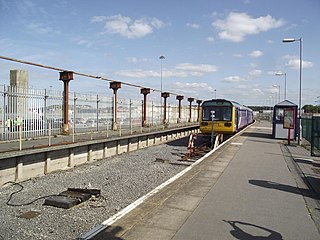
Heysham Port is a railway station on the Morecambe branch line, which runs between Lancaster and Heysham Port. The station, situated 7+3⁄4 miles (12 km) west of Lancaster, serves Heysham Port in Lancashire. It is owned by Network Rail and managed by Northern Trains.

Birmingham Moor Street, also known as Moor Street station, is one of three main railway stations in the city centre of Birmingham, England, along with Birmingham New Street and Birmingham Snow Hill.
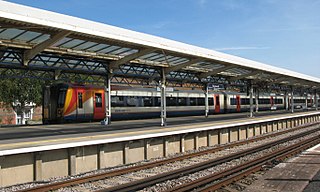
Weymouth is the main railway station serving the town of Weymouth, in Dorset, England; the other is at Upwey, which is located north of the town centre. It is the southern terminus of both the South West Main Line, 142 miles 64 chains (229.8 km) down the line from London Waterloo, and the Heart of Wessex Line from Bristol Temple Meads and Gloucester, 168 miles 63 chains (271.6 km) from London Paddington.

Bidston railway station serves the village of Bidston, Merseyside, England. The station is situated at a junction of the West Kirby branch of the Wirral line, which is part of the Merseyrail network; it also serves as the northern terminus for the Borderlands line from Wrexham Central, with services operated by Transport for Wales.
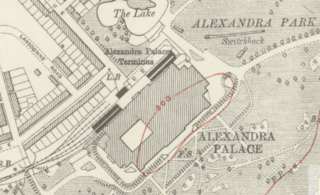
Alexandra Palace is a closed railway station in the grounds of Alexandra Palace in the Muswell Hill area of north London. It is one of a number of stations to have held the name at various times and should not be confused with the current Alexandra Palace station which is on the East Coast Main Line to the east of the closed station.

Wrexham Central railway station is the smaller of two railway stations serving the central area of Wrexham in Wales, the other being Wrexham General. The platform can accommodate a three car diesel train, but has room for platform extension. It is the southern terminus of the Borderlands Line, also known as the Wrexham-Bidston line, which links north-east Wales to Merseyside.

Bishop Auckland is a railway station that serves the market town of Bishop Auckland in County Durham, North East England, 11 miles 77 chains (19.3 km) north-west of Darlington. The station is the Western terminus of the Tees Valley Line, which links it to Saltburn via Darlington. It is owned by Network Rail and managed by Northern Trains.

Haggerston is a London Overground station in Haggerston, London, England, served by the East London line. It lies between Hoxton and Dalston Junction stations, is in Travelcard Zone 2, and is open 24 hours on a Friday and Saturday as part of the London Overground Night Service service. The station was rebuilt as part of the East London line extension.

Croxley Green railway station is a disused terminus between Rickmansworth and Watford on the A412 road at the end of a short branch line. Work began on the line in 1908 in response to the growing influence of the Metropolitan Railway, with a new passenger service to serve the Grand Union Canal.

Southampton Terminus railway station served the Port of Southampton and Southampton City Centre, England from 1840 until 1966. The station was authorised on 25 July 1834 and built as the terminus of the London and Southampton Railway, which later changed its name to the London and South Western Railway (LSWR). The station opened as "Southampton" on 11 May 1840 due to the track not being fully linked between Winchester and Basingstoke.

There are eleven disused railway stations on the Exeter to Plymouth line between Exeter St Davids and Plymouth Millbay in Devon, England. At eight of these there are visible remains.
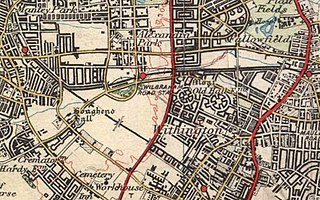
Wilbraham Road railway station was in Whalley Range, Manchester, England, on the Fallowfield Loop line between Manchester Central and Fairfield, via Chorlton. Opened as Alexandra Park in 1892 by the Manchester, Sheffield and Lincolnshire Railway, it was near the junction of Alexandra Road South and Mauldeth Road West, close to Alexandra Park, and served the expanding residential suburb of Whalley Range. The railway line has since been converted into a shared use path.
The Bangor and Carnarvon Railway was a railway company promoted to build a branch railway connecting Caernarfon with the main line at Bangor, in north-west Wales. It opened in 1852 as far as Port Dinorwic and was extended to Caernarfon later in the same year.

A train station, railroad station, or railroad depot and railway station is a railway facility where trains stop to load or unload passengers, freight, or both. It generally consists of at least one platform, one track, and a station building providing such ancillary services as ticket sales, waiting rooms, and baggage/freight service. Stations on a single-track line often have a passing loop to accommodate trains travelling in the opposite direction.

Morecambe Euston Road was the terminus station of the London and North Western Railway's branch line to Morecambe, in Lancashire, England. It closed in 1962, after which all trains to Morecambe used the nearby Morecambe Promenade station.
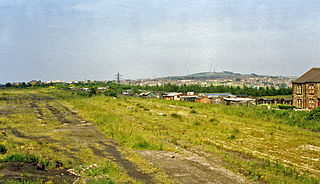
Consett was a railway station built by the North Eastern Railway on the route of the Stanhope and Tyne Railway, in County Durham, North East England. It served the industrial town of Consett, which was best known for its steelworks.

Tow Law railway station served the town of Tow Law, County Durham, England, from 1847 to 1965 on the Stanhope and Tyne Railway.
River Douglas railway station was a former railway station of the West Lancashire Railway (WLR) on the Southport-Preston Line in North West England, which opened in 1878. The station was near the village of Hesketh Bank, located approximately 550 yards (500 m) to the east of Hesketh Bank station, adjacent to an iron swing bridge on the western bank of the River Douglas.


















